Travel through Argentina and visit great places!
There is plenty to discover in Argentina! Visit tropical rainforests, ride through the pampas or cactus deserts and have your picture taken in front of the glistening ice-blue glacial fields. A vast stretch of 3700km lies between the most northern and the most southern Argentine city – Enough space to explore a unique and foreign world with its fascinating culture, breathtaking landscapes and hospitable residents.
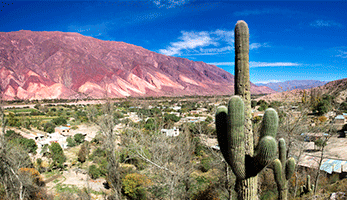 The Quebrada de Humahuaca is the highlight of the Argentine Northwest. The colourful rock formations have been attracting artists from all over the world in the past. It’s best to take a couple of days and visit the chain of small Indian villages and the remains of Inca fortresses that can be found along the 150km long canyon. Historically speaking, the Humahuaca was the entrance to one of the most crucial cultural routes alongside the river valley of the Rio Grande. It has played a major role as a trade and transport route for more than 10.000 years.
The Quebrada de Humahuaca is the highlight of the Argentine Northwest. The colourful rock formations have been attracting artists from all over the world in the past. It’s best to take a couple of days and visit the chain of small Indian villages and the remains of Inca fortresses that can be found along the 150km long canyon. Historically speaking, the Humahuaca was the entrance to one of the most crucial cultural routes alongside the river valley of the Rio Grande. It has played a major role as a trade and transport route for more than 10.000 years.
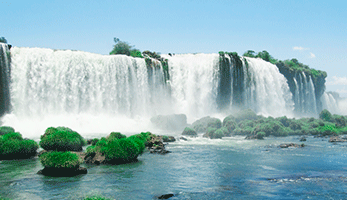 A breathtaking natural wonder and an absolute must-see destination for every traveller in Argentina are the Waterfalls of Iguazú: Experience how thousands of litres of water plummet fiercely from a height of 70 meters into a deep gorge. Along the 3km long front of the waterfalls, countless islands are scattered and the vast amounts of water produce all kinds and sizes of rainbows when the sun is shining. Explore the national park on foot or make a boat tour, which takes you close to the biggest fall named “Devil’s Abyss” (Garganta del Diablo)!
A breathtaking natural wonder and an absolute must-see destination for every traveller in Argentina are the Waterfalls of Iguazú: Experience how thousands of litres of water plummet fiercely from a height of 70 meters into a deep gorge. Along the 3km long front of the waterfalls, countless islands are scattered and the vast amounts of water produce all kinds and sizes of rainbows when the sun is shining. Explore the national park on foot or make a boat tour, which takes you close to the biggest fall named “Devil’s Abyss” (Garganta del Diablo)!
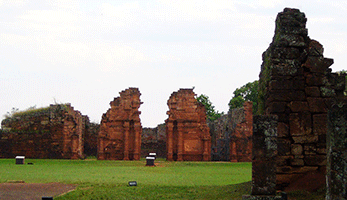 Many of these Christian Indian villages were destroyed during the border wars during the 19th century and their ruins have been successively covered by the jungle. The most beautiful and still visitable Jesuit missions is “Ignacio Mini”, containing arcade ambulatories, buildings made of basalt, and Indian church paintings. Also, worthwhile visiting are the missions of Santa Ana, Loreto, Candelaria and Santa Maria.
Many of these Christian Indian villages were destroyed during the border wars during the 19th century and their ruins have been successively covered by the jungle. The most beautiful and still visitable Jesuit missions is “Ignacio Mini”, containing arcade ambulatories, buildings made of basalt, and Indian church paintings. Also, worthwhile visiting are the missions of Santa Ana, Loreto, Candelaria and Santa Maria.
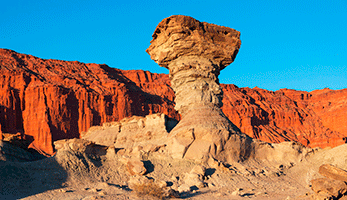 The Ischigualasto Provincial Park is located 320 km north of San Juan. Together with the Talampaya National Park it constitutes a huge eroded landscape of about 6000km2. In the “Valle de la Luna” (Valley of the Moon) countless science fiction movies have been filmed. Wind and water (millions of years ago there used to be huge lakes in that area) have shaped the rocks into great sculptures. Fossils, dinosaur marks, petrified grasses and ferns show that life existed in this exact place 200 millions of years ago. Among other things, the oldest dinosaur skeleton was found here!
The Ischigualasto Provincial Park is located 320 km north of San Juan. Together with the Talampaya National Park it constitutes a huge eroded landscape of about 6000km2. In the “Valle de la Luna” (Valley of the Moon) countless science fiction movies have been filmed. Wind and water (millions of years ago there used to be huge lakes in that area) have shaped the rocks into great sculptures. Fossils, dinosaur marks, petrified grasses and ferns show that life existed in this exact place 200 millions of years ago. Among other things, the oldest dinosaur skeleton was found here!
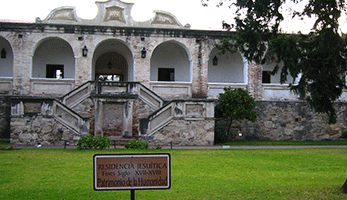 The Jesuit missions and Estancias of Córdoba are an extraordinary mixture of the indigenous culture and the European influence. The Jesuit facilities of Córdoba contain the main typical main of a Jesuit monastery: a university, a church, residential buildings and bordering Estancias that supplied the settlement. This setup reflects the attempt to base life in the mission in equal measure on religious and economic elements as well as the attempt to unite European culture with the culture of the natives.
The Jesuit missions and Estancias of Córdoba are an extraordinary mixture of the indigenous culture and the European influence. The Jesuit facilities of Córdoba contain the main typical main of a Jesuit monastery: a university, a church, residential buildings and bordering Estancias that supplied the settlement. This setup reflects the attempt to base life in the mission in equal measure on religious and economic elements as well as the attempt to unite European culture with the culture of the natives.
 The Nature Preserve Península Valdés is a peninsula on the Atlantic Coast of Patagonia. Annually, between May and December, the whales of the southern region gather there for mating. From the bay of Puerto Piramides, one can make a boat trip out onto the open sea to witness this extraordinary event. Also, the peninsula is home to other species: sea lions, elephant seals, and even the biggest penguin colony (several million animals) outside the Antarctic.
The Nature Preserve Península Valdés is a peninsula on the Atlantic Coast of Patagonia. Annually, between May and December, the whales of the southern region gather there for mating. From the bay of Puerto Piramides, one can make a boat trip out onto the open sea to witness this extraordinary event. Also, the peninsula is home to other species: sea lions, elephant seals, and even the biggest penguin colony (several million animals) outside the Antarctic.
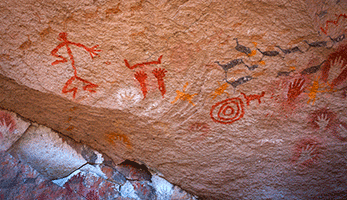 Rock paintings can be found in plenty of mountainous regions in Argentina. But the most famous is the rock art in the “Cueva de las manos pintadas” (“Cave of the painted hands”) in the canyon of Río Pinturas in the northwest of Santa Cruz. There, you can find depictions of hands dating back to about 7350 B.C. Furthermore, paintings of hunting scenes, of animals like llamas and pumas, that are still to be found in the region today, are shown. It is assumed that the descendants of those tribes that created the rock paintings had lived in these caves until the arrival of the first European settlers in the 17th century.
Rock paintings can be found in plenty of mountainous regions in Argentina. But the most famous is the rock art in the “Cueva de las manos pintadas” (“Cave of the painted hands”) in the canyon of Río Pinturas in the northwest of Santa Cruz. There, you can find depictions of hands dating back to about 7350 B.C. Furthermore, paintings of hunting scenes, of animals like llamas and pumas, that are still to be found in the region today, are shown. It is assumed that the descendants of those tribes that created the rock paintings had lived in these caves until the arrival of the first European settlers in the 17th century.
 The glaciers in the Los Glaciares National Park are without doubt one of the most thrilling natural wonders on earth. While most glaciers worldwide are losing mass due to the global warming, you can watch the famous “Perito Moreno” glacier growing. From time to time and resulting from great pressure, giant blocks or ice towers tumble into the “Lago Argentino”, accompanied by the sound of raving thunder. Tons of ice, the sizes of the mountains and the beauty of the lakes leave you unforgettable impressions.
The glaciers in the Los Glaciares National Park are without doubt one of the most thrilling natural wonders on earth. While most glaciers worldwide are losing mass due to the global warming, you can watch the famous “Perito Moreno” glacier growing. From time to time and resulting from great pressure, giant blocks or ice towers tumble into the “Lago Argentino”, accompanied by the sound of raving thunder. Tons of ice, the sizes of the mountains and the beauty of the lakes leave you unforgettable impressions.
